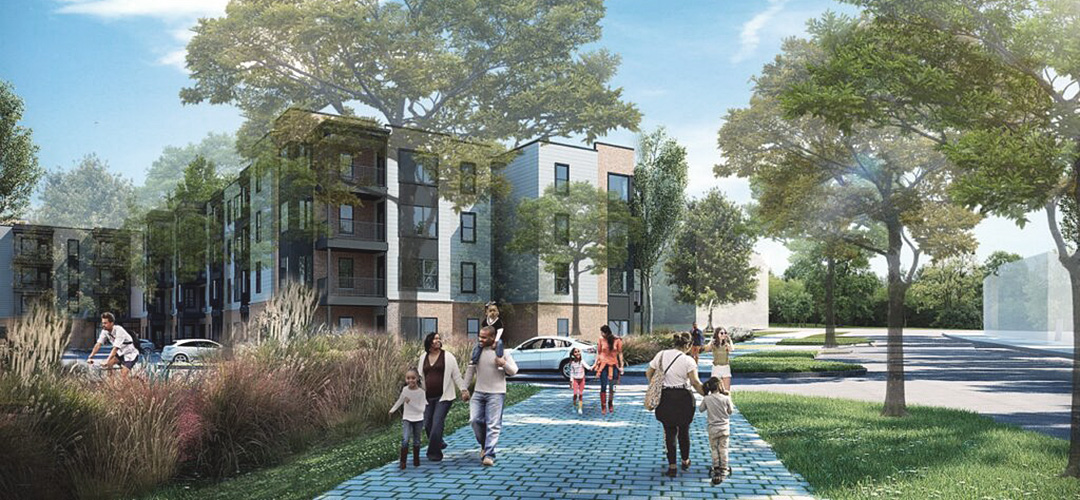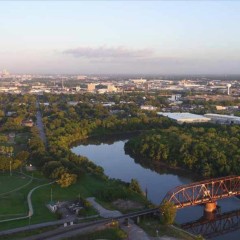This post was originally published by the Houston Chronicle.
The water fountains worked fine, but the restrooms were locked up tight. It took me a while to find a spot that offered a view of Buffalo Bayou, just north of the park. And on the nicest day in Houston since long-ago spring, the only visitors besides me were a dozen or so staff and volunteers with the Texas Organizing Project, clustered in the shade of the gazebo as they prepared for an afternoon of block-walking.
Less than a mile away, a rusted shipping container on the edge of an empty parking lot marked the site of Japhet Creek, a bayou tributary that was barely visible through the trees. While I poked around the site, a stray dog was my only companion until a young man showed up and started hiking along a rough path that follows the creek.
Houston’s merry band of bayou improvement advocates envisions bigger and better things for Tony Marron Park, Japhet Creek and many other spots along the bayou east of downtown. Marron Park was the site of a Sept. 26 news conference announcing a $100 million gift from the Kinder Foundation to help fund a master plan for parks along Buffalo Bayou in the East End and Fifth Ward neighborhoods.
As the Chronicle’s Diane Cowen reported, the gift from philanthropists Nancy and Rich Kinder will serve as a catalyst for additional funds from the city of Houston, Harris County, federal housing tax credits, and future fund-raising by the Buffalo Bayou Partnership, which in 2019 released the master plan that brings together work from many leading landscape architecture firms. One of the first planned projects, with work starting early next year, is to create a pocket park at Japhet Creek, later connected to an expanded Tony Marron Park by a pedestrian bridge, Cowen reported.
As I read about the Kinders’ gift, I recalled an article I wrote for the Chronicle almost exactly 20 years ago, on Sept. 22, 2002, when the bayou partnership released a master plan entitled “Buffalo Bayou and Beyond.” The 191-page document envisioned dozens of improvement projects along the bayou from Shepherd Drive to the Ship Channel Turning Basin, with an additional goal of encouraging private development in adjacent neighborhoods. “All over the world, great cities are reinventing themselves around their waterfronts,” an overview of the plan stated. “Think of New York's harbor, Chicago’s lakefront, Baltimore’s inner harbor, San Francisco’s bay, Barcelona’s seafront, Paris’ Seine riverfront, and London’s South Bank and Docklands.”
When my editor read those words — the Seine? San Francisco Bay? Really? — her eyes rolled, figuratively if not literally. She said my story should be more skeptical. I pointed out that I wasn’t reporting this as a done deal, only as a plan, but she wasn’t fully mollified. Today, of course, the award-winning Buffalo Bayou Park in its western sector from Shepherd to downtown shows that the plan was more than a pipe dream. The park, which was largely designed to withstand flooding, was tested by a series of floods during construction and then Hurricane Harvey; its resilience and innovative design impressed judges from the Urban Land Institute and earned the park a win in the 2017-2018 Global Awards for Excellence. Even that achievement, though, merely shifted rather than silenced the skepticism: Sure, they’ve built a lovely park on the side of town where better-off, mostly white people live, but what about those who live outside the “Houston Arrow,” which my colleague Leah Binkovitz has so ably described.
The Kinder Foundation gift is a welcome response to the inequities Binkovitz documented, which have persisted since Houston’s leaders began to understand that “quality of life” features like parks and trails are vital elements of any city that aspires to greatness. The Shepherd-to-downtown segment of Buffalo Bayou Park teems with activity most days — Spandex-clad cyclists zip past moms pushing strollers, couples lounge in the grass alongside a group playing volleyball, a family spreads out a blanket for a picnic in the shade of towering oak trees a stone’s throw from the bayou. People in the predominantly Black and Hispanic neighborhoods along the bayou’s eastern segment deserve the same activities, the same joy. The gift from the Kinders, who have also donated generously to other major Houston parks projects, shows that some of the city’s most influential citizens recognize this inequity and are determined to correct it.
The many users and admirers of the existing Buffalo Bayou Park should not expect a carbon copy east of downtown. The adjoining neighborhoods have different populations with different cultures, and the eastern improvements aim to reflect that, based on input gathered from area residents during planning.
“We’re not picking up Buffalo Bayou Park and plopping it over in the East End,” Anne Olson, the president of the Buffalo Bayou Partnership, told me. For example, the eastern segment will not have a dog park — a hugely popular feature of the current park — because most of the people who attended community meetings said they didn’t want one.
Perhaps the greatest skepticism now is not whether the park will draw people or whether investment will go into Black and Hispanic neighborhoods, but whether it will accelerate gentrification. Will the very people who have long been outside “the arrow” be displaced just as their parks and other amenities improve?
Importantly, the first project planned in this initiative is not a park: It’s an affordable housing development. The project will start with 80 multi-family units, developed with federal tax credits in a joint venture between the Buffalo Bayou Partnership and Chicago-based development firm Brinshore, Olson said. It will stand at the bayou’s intersection with Lockwood.
That this project has been given such priority shows a recognition of the risk that emerges when high-quality public spaces are developed in low-income neighborhoods. The concern is that these projects will make the neighborhoods more desirable, raise property values and hence raise taxes, pushing out people who can’t afford the higher levies. It seems absurd to argue that high-quality parks should be withheld from neighborhoods that need them, yet the concern is not without foundation. In Manhattan, the conversion of abandoned tracks into the High Line park initially generated a kind of euphoria that turned into bitterness as longtime residents and businesses were priced out of adjacent neighborhoods. Recognizing their mistakes, the High Line leadership put together a network of major infrastructure reuse projects around the country, including Buffalo Bayou Park, to share lessons on incorporating affordability and equity in plans from the get-go.
Still, there’s only so far a park plan can go. The long-term answer is a fairer state tax structure and greater income equality, but in the meantime, it’s heartening to see efforts like this housing development that try to address the issue, however incompletely. As Olson told me, “We can’t solve all the problems in the world.”
Perhaps not, but the Buffalo Bayou Partnership, the Kinder Foundation and others involved in this initiative deserve the thanks of every Houstonian, not just those in the adjacent neighborhoods. A bigger, better, fairer parks system makes for a better city, something that gives us all bragging rights. Even the skeptics.
Mike Snyder is a Houston writer who retired from the Houston Chronicle in 2019 after 40 years as a reporter, editor and columnist.
The views, information or opinions expressed in Urban Edge posts are those of the author and do not necessarily represent those of the Kinder Institute for Urban Research.


